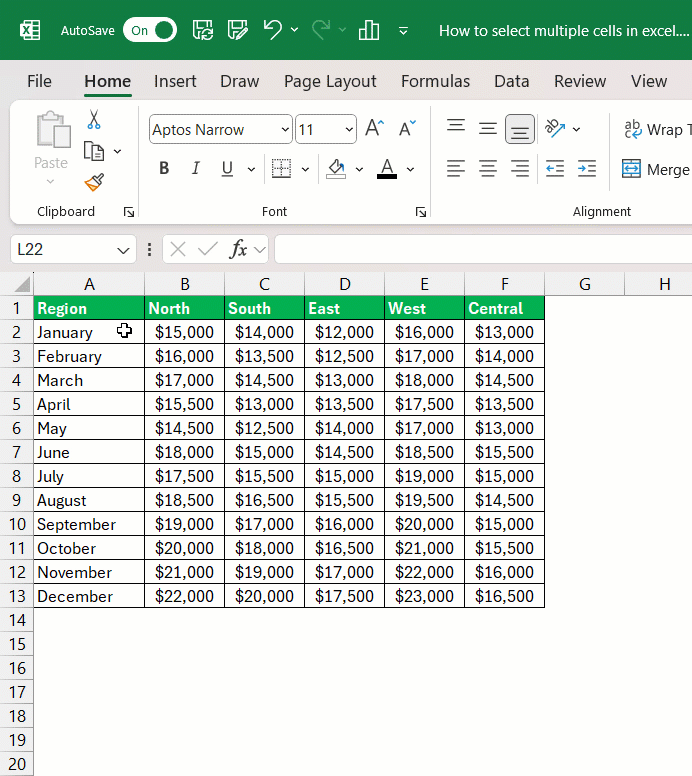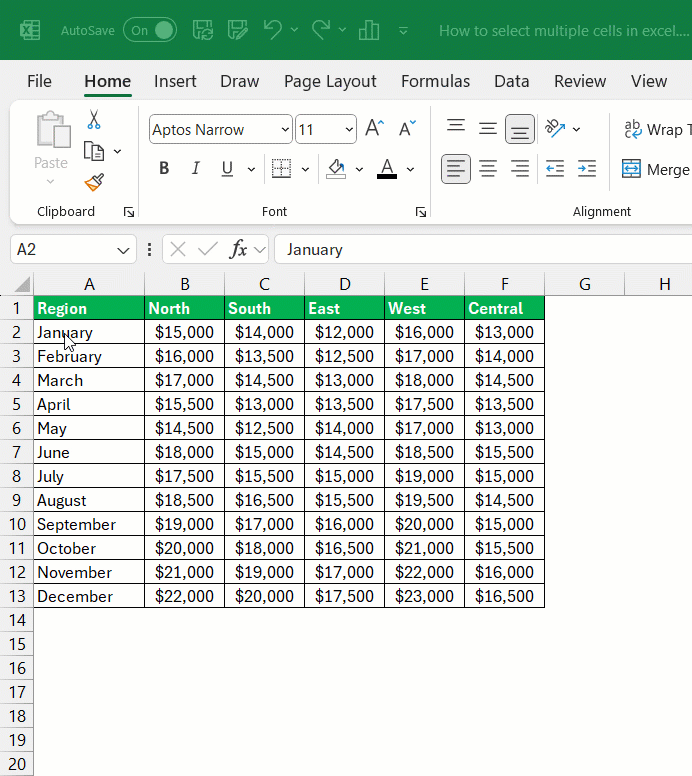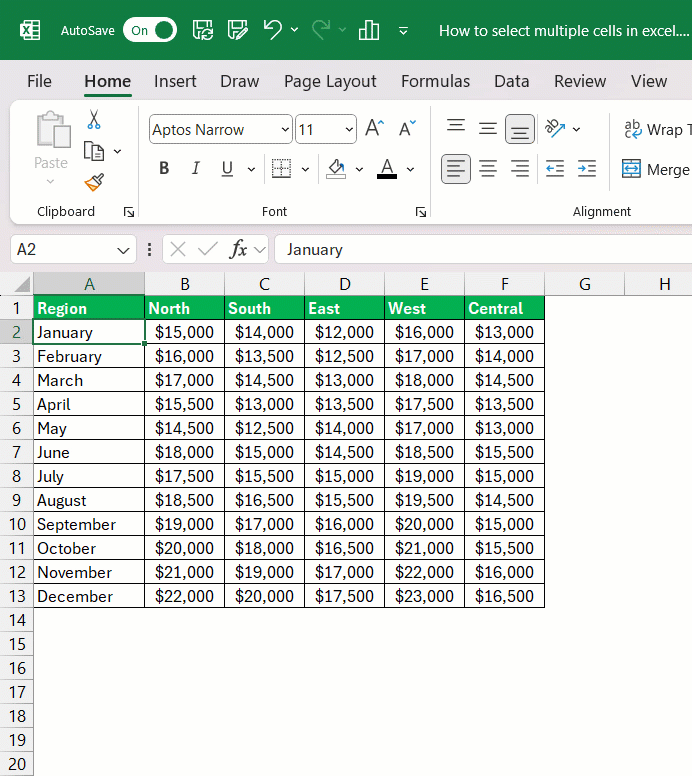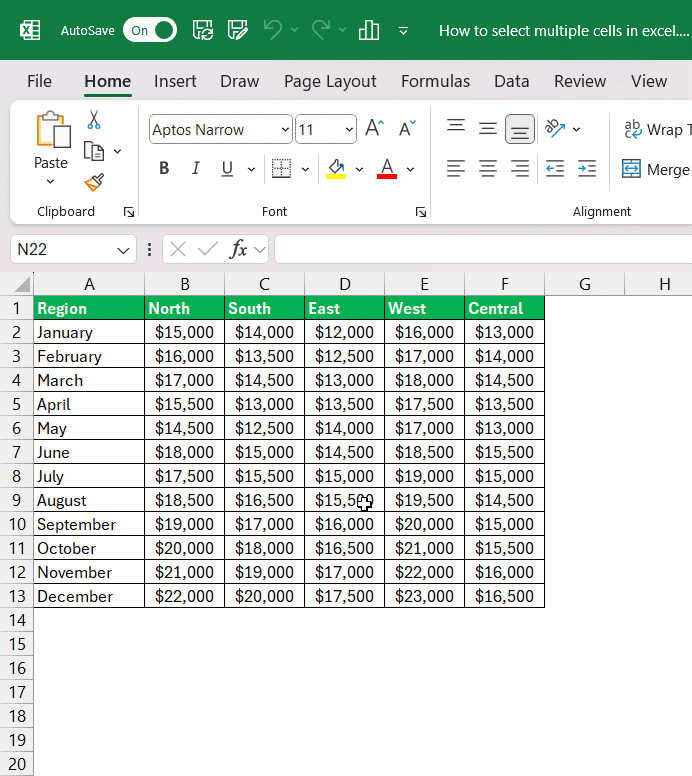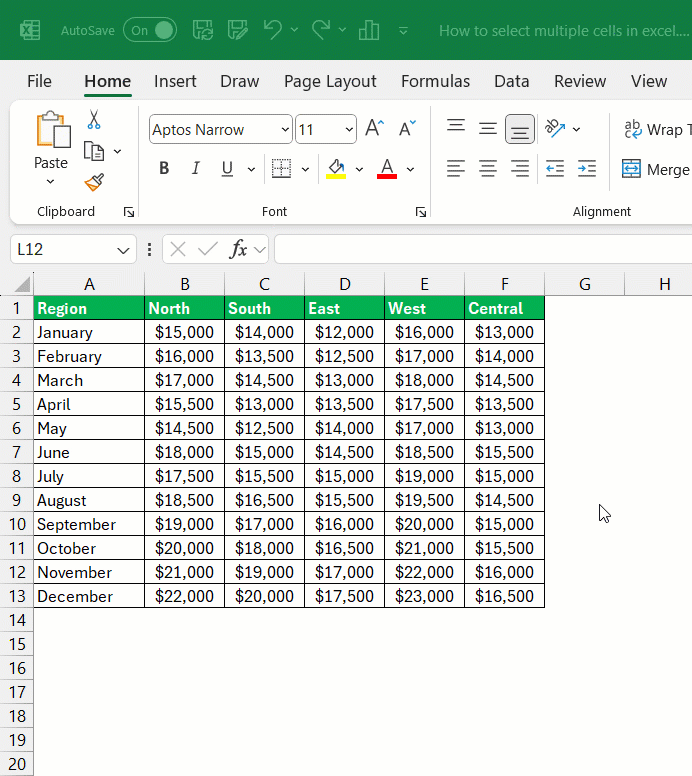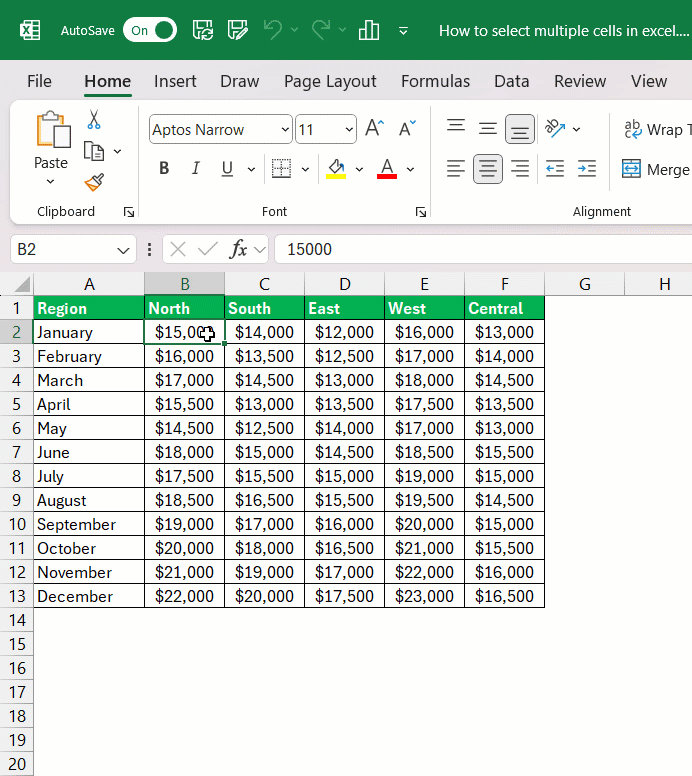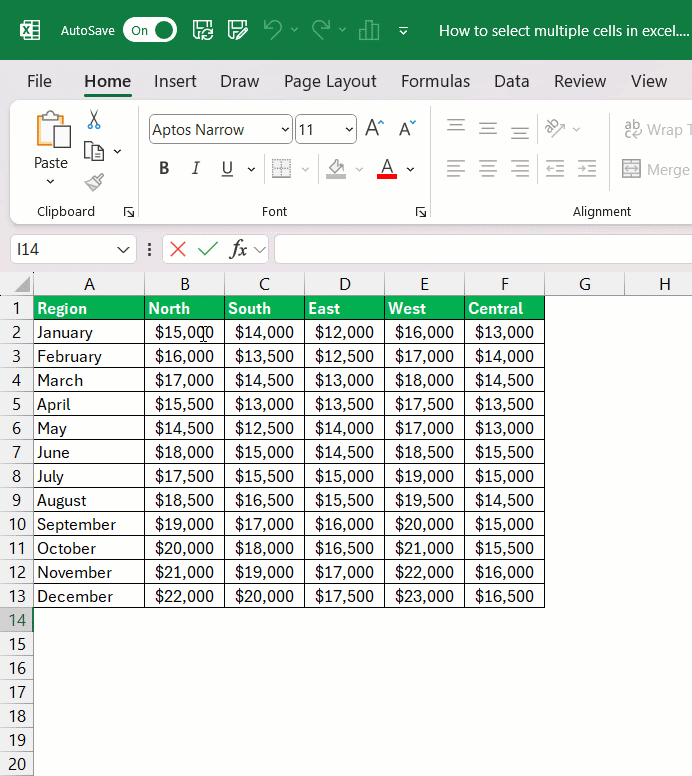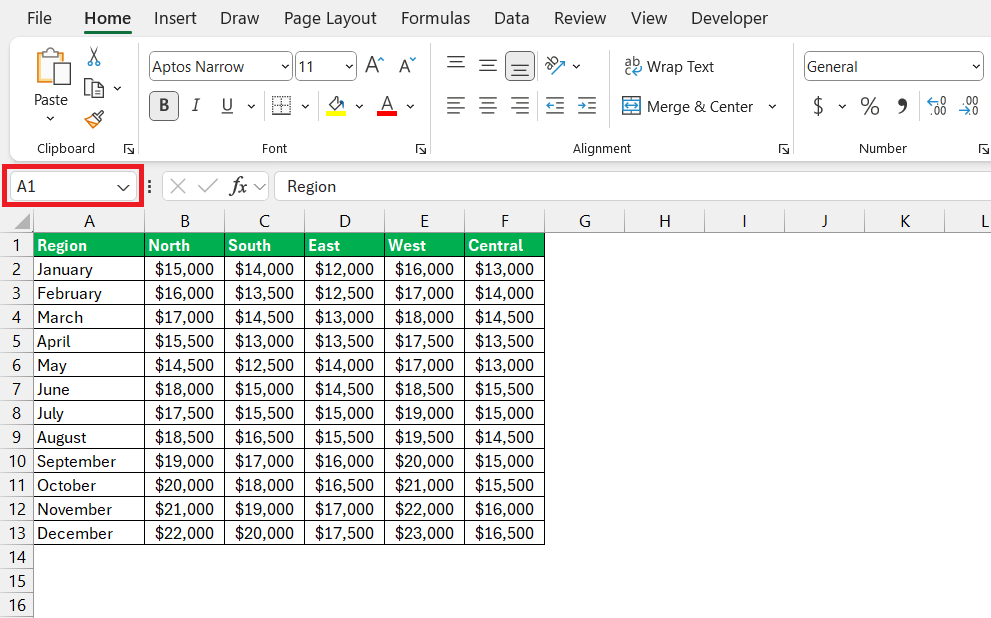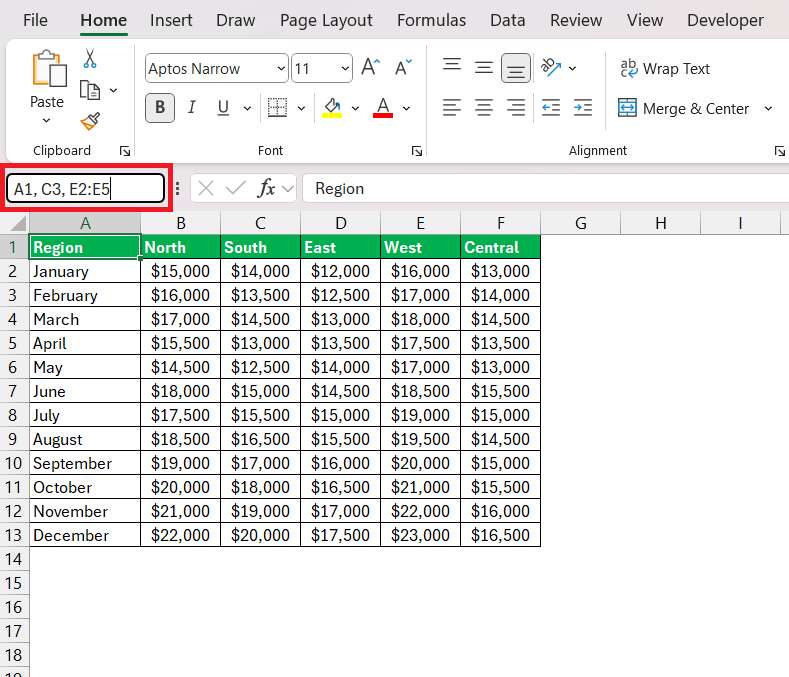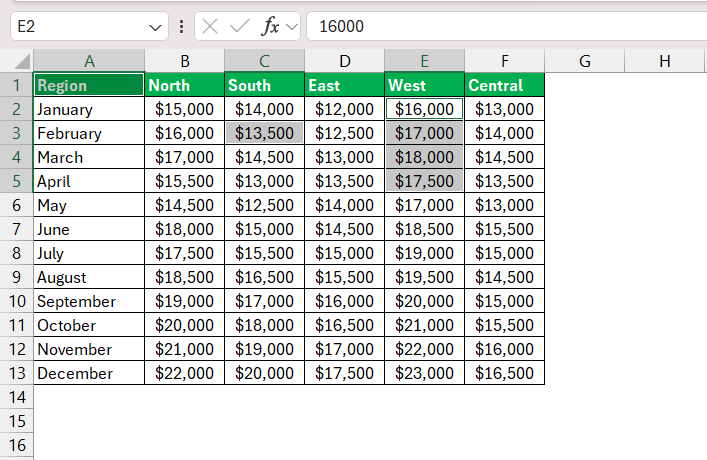Selecting multiple cells in Microsoft Excel is a fundamental skill that enhances efficiency and precision in data management. Whether you’re performing data entry, formatting, or analysis, mastering various cell selection techniques can significantly streamline your workflow. This guide will introduce you to how to select multiple cells, ensuring you can handle your Excel tasks with ease and accuracy.
Key Takeaways:
- Mastering keyboard shortcuts like Ctrl + A to select all cells, Shift + Arrow Key to extend selection, and Ctrl + Shift + Arrow Key for quick block selection can drastically reduce the time spent on routine tasks.
- Using the mouse for selecting single cells, entire columns, or specific ranges provides precise control, essential for detailed data work and formatting tasks.
- The click-and-drag method is intuitive and effective for selecting consecutive cells quickly, ideal for bulk editing and formatting.
- Leveraging the Shift key allows for rapid selection of large ranges without dragging, minimizing errors and making the process more efficient.
- For non-adjacent cells, using the Ctrl key enables precise selections without affecting other data. The Name Box offers a powerful way to select complex cell ranges by entering cell references directly.
Table of Contents
Introduction to Excel Cell Selection Techniques
The Importance of Efficiently Selecting Cells
When working with Excel, selecting cells is a fundamental skill that massively impacts your productivity and data manipulation efficiency. Whether you’re an accountant poring over financial statements or a researcher analyzing data sets, knowing shortcuts and techniques to select more than one cell can shave hours off your workweek. This convenience allows you to format, analyze, and manage your data in Excel with unparalleled speed and precision.
Different Selection Needs for Smart Editing
Different tasks in Excel require various selection approaches. For smart editing, you might need to select columns for bulk formatting, rows for data entry, or individual cells for specific alterations. Whether you’re performing calculations or setting up data validation rules, each editing chore may necessitate a unique selection technique.
By understanding the diverse selection needs, you can streamline your workflow, avoid repetitive strains, and ensure that your edits are accurate and efficient.
Crafting Your Excel Selection Skills
Keyboard Shortcuts to Speed Up Selection
Unlock the power of efficiency in Excel with keyboard shortcuts designed to speed up cell selection. These keystrokes are the shortcuts to success for anyone looking to enhance their productivity:
- Ctrl + A: Instantly select all the cells in your worksheet. If you press this command within a data region, it selects the enclosed area initially, and pressing it again expands the selection to the entire sheet.
- Shift + Arrow Key: Extend your selection in the arrow key’s direction while holding down the Shift key, perfect for quickly highlighting a series of cells.
- Ctrl + Shift + Arrow Key: This combination allows you to select all cells in a block from your starting point to the last filled cell in the column or row.
By incorporating these shortcuts into your Excel toolkit, you’ll transform lengthy tasks into a few simple taps on your keyboard.
Mouse Techniques for Precise Control
For pinpoint precision in cell selection, your mouse is a trusty ally. Here’s how you can use it to your advantage:
- Begin by hovering the mouse cursor over the cell you wish to select. For a single cell, a simple click will suffice.
- When needing to select an entire column, move the cursor to the column header and wait for the small black selection arrow to appear, then click. This selects all cells in that column.
These mouse techniques offer you the finest control, ensuring you select exactly what you need with ease and specificity.
Selecting Singular and Multiple Cells
Click and Drag Basics
The click-and-drag technique is a staple in the Excel user’s toolbox. For adjacent cells, simply:
- Click on the first cell in the range.
- Hold the left mouse button down and drag across or down to the last required cell.
- Release the button to complete the selection.
This method feels natural and is incredibly useful for speedily highlighting cells that you want to work on consecutively.
Leveraging the Shift Key for Range Selection
The Shift key is your best friend for quick range selections. Here’s a step-by-step guide to making the most out of this handy feature:
- Click the first cell in the range you want to select.
- Hold down the Shift key.
- While holding Shift, click the last cell in the range.
Voilà! Excel selects all cells between the first and last one you clicked. It’s like magic for creating large selections without dragging and potentially making mistakes.
Advanced Techniques for Non-Adjacent and Special Ranges
Mastering the Control Key for Non-Continuous Selections
Navigating non-continuous selections in Excel becomes effortless once you master the Control key. Follow these steps for a seamless experience:
- Click on the first cell or range you want to select.
- Hold down the Ctrl key (or Command key on Mac).
- Click on each additional non-adjacent cell or range.
Remember, if your aim strays and you accidentally include an unwanted cell, clicking it again with the Ctrl key held down deselects it. This level of control ensures precision when working with complex data sets.
Using Name Box for Complex Selections
The Name Box is located to the left of the formula bar, directly above the worksheet area. It typically shows the cell reference of the currently selected cell (e.g., A1). For selections that demand extra finesse, Excel’s Name Box are invaluable tool. Let’s dive in:
STEP 1: Click inside the Name Box to place your cursor there.
STEP 2: To select multiple cells, you need to enter the cell references separated by commas. For example: Type A1, C3, E2:E5, and press Enter.
Excel will then highlight all the specified cells.
Using these tools streamlines complex selections, making it easier to manipulate large or dispersed data sets with minimal effort.
FAQ Section
How do you select multiple cells at once in Excel?
To select multiple cells at once in Excel, click and hold the left mouse button on the first cell, then drag to include additional cells in the selection. Alternatively, use the Shift key to select a range by clicking the first cell, holding Shift, and clicking the last cell in the range. For non-adjacent cells, hold the Ctrl key while clicking on individual cells.
How do I select non-adjacent cells using only the keyboard?
Use the Shift + F8 keys to start ‘Add to selection’ mode. Then navigate to the next cell with arrow keys and use Shift + Arrow keys to select it. Repeat this for other non-adjacent cells you wish to include in the selection.
What is the quickest way to select all cells below the current cell until the last filled cell?
The quickest way is to press Ctrl + Shift + Down Arrow. This selects all cells below your starting point down to the last filled cell in the column.
How do you select multiple cells that aren’t together in Excel?
To select cells that aren’t together in Excel, click on the first cell, then hold down the Ctrl key (Command on Mac) and click on each additional cell you want to include in your selection. Release the Ctrl key when done.
How to select a large range of cells in Excel without scrolling?
To select a large range of cells without scrolling, click the initial cell, hold Shift, and select the last cell of the range using the keyboard arrow keys. For an even larger selection, use Ctrl + Shift + Arrow key to expand the selection to the last non-empty cell.
John Michaloudis is a former accountant and finance analyst at General Electric, a Microsoft MVP since 2020, an Amazon #1 bestselling author of 4 Microsoft Excel books and teacher of Microsoft Excel & Office over at his flagship MyExcelOnline Academy Online Course.

